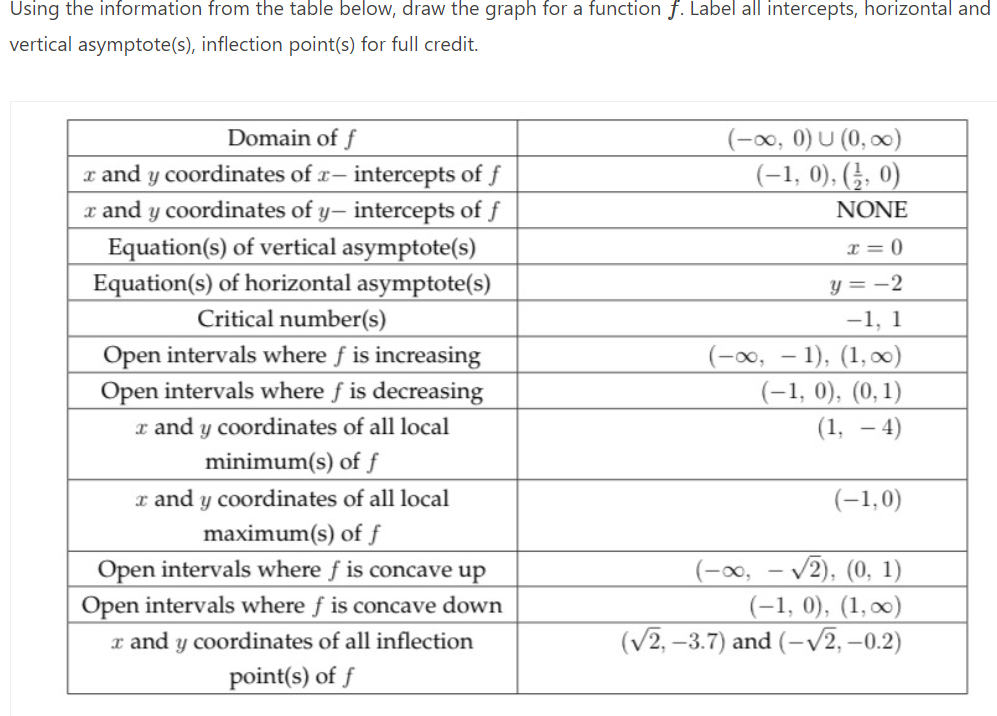intervals where f is increasing intervals where f is decreasing of all local of f of all local and y coordinates minimum(s) and y coordinates maximum(s) of f intervals where f is concave up tervals where f is concave down dy coordinates of all inflection (√2,-3.7) am
intervals where f is increasing intervals where f is decreasing of all local of f of all local and y coordinates minimum(s) and y coordinates maximum(s) of f intervals where f is concave up tervals where f is concave down dy coordinates of all inflection (√2,-3.7) am
College Algebra
7th Edition
ISBN:9781305115545
Author:James Stewart, Lothar Redlin, Saleem Watson
Publisher:James Stewart, Lothar Redlin, Saleem Watson
Chapter2: Functions
Section2.6: Transformations Of Functions
Problem 104E
Related questions
Question

Transcribed Image Text:Using the information from the table below, draw the graph for a function f. Label all intercepts, horizontal and
vertical asymptote(s), inflection point(s) for full credit.
Domain of f
x and y coordinates of r- intercepts of f
x and y coordinates of y- intercepts of f
Equation(s) of vertical asymptote(s)
Equation(s) of horizontal asymptote(s)
Critical number(s)
Open intervals where f is increasing
Open intervals where f is decreasing
x and y coordinates of all local
minimum(s) of f
x and y coordinates of all local
maximum(s) of f
Open intervals where f is concave up
Open intervals where f is concave down
x and y coordinates of all inflection
point(s) of f
(-∞, 0) U (0, ∞)
(−1, 0), (¹, 0)
NONE
x=0
y=-2
−1, 1
-∞, -1), (1, 0)
(-1,0), (0, 1)
(1,-4)
(-1,0)
(-∞,
√2), (0, 1)
(-1,0), (1,00)
(√2, -3.7) and (-√2,-0.2)
Expert Solution
This question has been solved!
Explore an expertly crafted, step-by-step solution for a thorough understanding of key concepts.
Step by step
Solved in 2 steps with 1 images

Recommended textbooks for you

College Algebra
Algebra
ISBN:
9781305115545
Author:
James Stewart, Lothar Redlin, Saleem Watson
Publisher:
Cengage Learning

Glencoe Algebra 1, Student Edition, 9780079039897…
Algebra
ISBN:
9780079039897
Author:
Carter
Publisher:
McGraw Hill

Algebra & Trigonometry with Analytic Geometry
Algebra
ISBN:
9781133382119
Author:
Swokowski
Publisher:
Cengage

College Algebra
Algebra
ISBN:
9781305115545
Author:
James Stewart, Lothar Redlin, Saleem Watson
Publisher:
Cengage Learning

Glencoe Algebra 1, Student Edition, 9780079039897…
Algebra
ISBN:
9780079039897
Author:
Carter
Publisher:
McGraw Hill

Algebra & Trigonometry with Analytic Geometry
Algebra
ISBN:
9781133382119
Author:
Swokowski
Publisher:
Cengage

Functions and Change: A Modeling Approach to Coll…
Algebra
ISBN:
9781337111348
Author:
Bruce Crauder, Benny Evans, Alan Noell
Publisher:
Cengage Learning